Peel and Stick Bathroom Flooring: Practical Guide
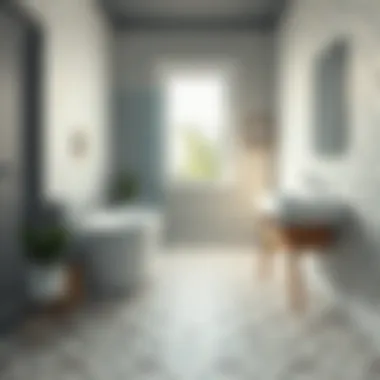
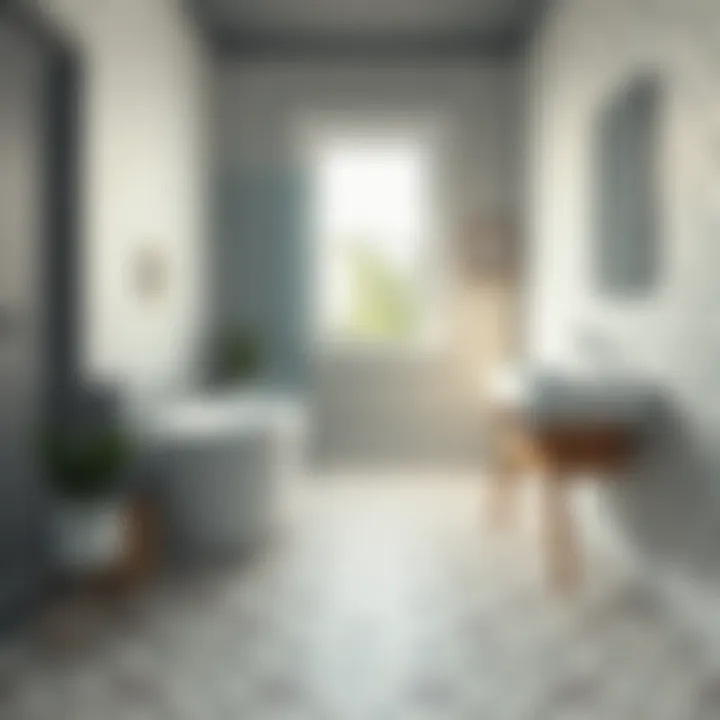
Intro
In recent years, the home improvement landscape has seen a surge in innovative flooring options, and peel and stick bathroom flooring has captured the attention of many homeowners and design aficionados alike. Not only is it budget-friendly, but it also allows for an effortless transformation of your bathroom space. Whether you’re aiming for a sleek modern look or a cozy rustic vibe, this flooring type has something to offer everyone. Through this comprehensive guide, we will delve into the materials, installation techniques, design inspirations, and maintenance practices that make peel and stick flooring an enticing option.
From flooring styles that are currently trending to practical maintenance tips, this article serves to inform and inspire those looking to elevate their bathrooms. Let’s peel back the layers on this convenient and stylish flooring solution.
Design Inspirations
When it comes to design, peel and stick flooring can certainly set the stage for a remarkable bathroom ambiance. Here we explore notable trends and color schemes that resonate with diverse aesthetics.
Trending Styles
Peel and stick flooring comes in an array of styles, making it easy to find a design that perfectly suits your taste. Some of the most popular styles today include:
- Wood Plank Aesthetic: Ideal for those who enjoy a warm, inviting look. This style emulates the appearance of natural wood without the hefty upkeep.
- Geometric Patterns: For a modern and edgy vibe, consider bold geometric designs. These offer a distinct look that can be a conversation starter.
- Marble Effect: If you wish to channel a more sophisticated ambiance, marble-effect tiles can provide that luxurious feel at a fraction of the cost.
These styles truly exemplify how versatile peel and stick flooring can be, fitting seamlessly into various interior styles.
Color Palettes
The choice of color matters enormously in how a space feels. The beauty of peel and stick flooring lies in its ability to complement your existing decor. Here are some popular palettes:
- Neutral Tones: Shades like taupe, beige, or soft gray can create a soothing atmosphere.
- Bold Accents: Deep blacks or navy blues can add drama to your bathroom, making it feel both contemporary and chic.
- Earthy Hues: Greens and browns can bring a touch of nature indoors, perfect for the environmentally conscious homeowner.
Each color option can affect the perception of space, light, and comfort, so it's worth considering what kind of mood you wish to evoke.
"Choosing the right design and color can turn your bathroom from ordinary to extraordinary, all while staying within budget."
In summary, peel and stick bathroom flooring provides a wealth of possibilities when it comes to design. With so many styles and colors available, it’s easy to find a perfect match for your vision.
Maintenance and Upkeep
Like any home improvement, maintaining your peel and stick flooring is crucial to ensure its longevity and aesthetic appeal. Here are some insights into keeping your bathroom flooring in tip-top shape.
Seasonal Maintenance Checklist
To keep your flooring looking fresh, consider these maintenance tasks that should be performed regularly:
- Monthly Check: Inspect the corners and edges for any signs of lifting or wear. Adhere any loose sections back down promptly.
- Quarterly Scrub: Perform a deep clean using appropriate cleaners that won’t harm the adhesive. Gentle solutions are typically best.
- Annual Review: Take a comprehensive look at the flooring's condition to determine if replacement or repairs are necessary.
Cleaning and Organization Tips
A well-maintained floor is a joy to behold, and keeping it clean requires some straightforward practices:
- Use Soft Mops: Instead of a rough brush, use soft bristle mops for cleaning to avoid scratching.
- Spill Management: Address any spills immediately. A damp cloth will usually do the trick without the need for harsh chemicals.
- Organization: Ensure that items are placed thoughtfully to avoid wear and tear. Consider storage solutions that keep foot traffic patterns in mind.
Continuing care of your peel and stick flooring will not only preserve its beauty but also extend its lifespan. With proper cleaning and periodic checks, you can enjoy your bathroom oasis for years to come.
Foreword to Peel and Stick Flooring
When considering enhancements for a bathroom, many homeowners are looking for solutions that marry style with functionality. Among the myriad options available, peel and stick flooring has gained traction as a popular choice. This innovative flooring solution offers an enticing balance of ease and aesthetic appeal, making it a compelling contender for modern bathrooms.
What is Peel and Stick Flooring?
Peel and stick flooring is, at its core, a type of flooring that comes with a self-adhesive backing, allowing for a straightforward installation process. Unlike traditional flooring materials that may require professional installation techniques, this option empowers homeowners to take matters into their own hands. All you need to do is peel off the backing and stick it onto a clean, flat surface.
The appeal is multifaceted. For one, it is commonly made from vinyl, which is known for its versatility and durability. From tile-like appearances to plank-style designs, the options available have expanded tremendously to cater to diverse tastes. Additionally, the user-friendly nature of this flooring appeals to DIY enthusiasts and anyone looking to elevate their spaces without breaking the bank or undergoing lengthy renovations.
Historical Context of Bathroom Flooring
Throughout history, bathroom flooring has seen considerable evolution. In times past, bathrooms often featured cold tile or concrete floors, providing little comfort and aesthetic warmth. Over the decades, as home design transformed, so too did the options available for flooring.
In the mid-20th century, linoleum became a household staple due to its affordability and ease of maintenance, but it lacked the diversity in styles that many desired. Fast forward to today, peel and stick flooring has emerged as a game changer, signaling a shift toward more stylish and accessible solutions while integrating modern materials and technology.
In fact, industry trends show that more homeowners are opting for flooring solutions that combine the essence of luxury with the practicality of a simple installation process.
As we explore this guide, understanding peel and stick flooring—from its inception to how it fits into contemporary design trends—offers valuable insights into modern bathroom enhancements. A growing DIY community is paving the way for this flooring option to shine, making it a relevant choice for remodeling enthusiasts and casual renovators alike.
Advantages of Peel and Stick Flooring
Peel and stick flooring has taken the home renovation scene by storm, particularly in bathroom spaces. These tiles not only cater to aesthetic inclinations but also boast practical advantages that appeal to a wide range of homeowners and design enthusiasts. With affordability, user-friendly installation, and a wealth of design options, peel and stick flooring truly serves as a versatile solution for those looking to revamp their bathrooms. Understanding the core benefits of this flooring type is essential for making well-informed decisions when embarking on your next interior project.
Cost-Effectiveness
One of the primary attractions of peel and stick flooring is its wallet-friendly nature. Traditional flooring installations can sting your purse, often requiring professional help or intricate tools. With peel and stick, it's a whole different ball game. The self-adhesive backing allows for a DIY approach. Homeowners can lay the tiles themselves without having to dig deep into their pockets for labor costs or special equipment. The costs associated with peel and stick flooring are significantly lower, which can make it an appealing option for those on tight budgets or looking for short-term solutions.
In practical terms, consider this: a bathroom renovation typically costs a few thousand dollars, but by opting for peel and stick tiles, you may only shell out a few hundred. This reduces the overall expenditure while providing the flexibility to switch styles or conduct multiple renovations over the years without breaking the bank.
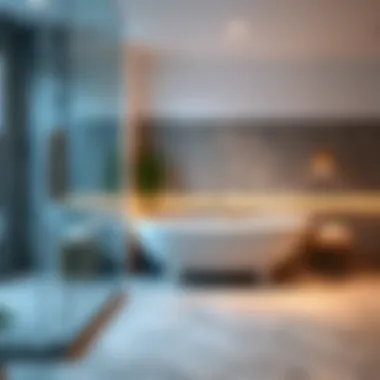
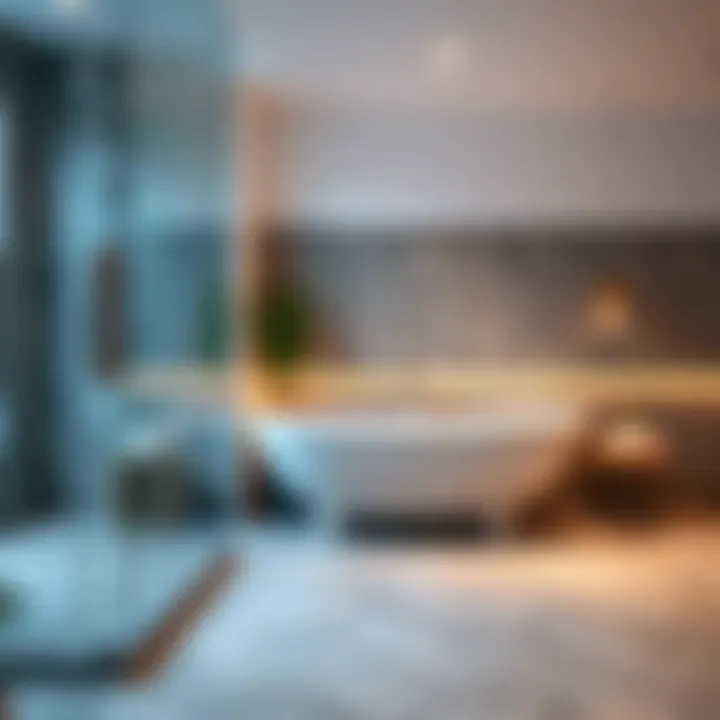
Ease of Installation
Installing peel and stick flooring can feel like a breath of fresh air, particularly when you consider the hassle involved in traditional flooring methods. Forget about complicated subfloor requirements or lengthy drying times associated with adhesives; peel and stick allows you to transform your space with minimal fuss. The installation is simple—just peel back the protective layer and stick the tile down on a clean, dry surface.
This process invites a sense of freedom for homeowners who relish the hands-on experience of home improvement. Whether it’s a weekend project or a spur-of-the-moment decision, the straightforwardness of installation means that you can dive right in. Plus, if you make a mistake, it’s generally easy to reposition a tile without damage, making it a forgiving option for first-timers.
“Peel and stick tiles are akin to painting on a canvas; the ease of placement empowers you to get creative.”
Variety of Designs and Styles
When it comes to variety, peel and stick flooring doesn’t cut corners. From rustic wood looks to chic marble finishes, there’s something to suit every style and taste. Contemporary designs often feature intricate patterns, while classic styles echo the feel of traditional tile. This means you can tailor your bathroom to reflect your unique personality without feeling limited by your budget.
Additionally, the versatility of peel and stick tiles encourages mixing and matching for a truly personalized space. For example, consider pairing geometric tiles with solid colors to create a modern effect. Such options make peel and stick flooring an excellent choice for those looking to develop a layered design scheme without the intimidation that often accompanies significant aesthetic commitments.
A brief exploration of the available styles includes:
- Wood-Look: Perfect for a warm, rustic feel while being water-resistant for bathroom use.
- Stone Textures: Ideal for a contemporary flair, offering the elegance of slate or granite.
- Patterned Tiles: Great for a bold statement, bringing fun and personality to the space.
The vast array of designs ensures that homeowners and decorators alike have the tools necessary to craft spaces that resonate with their personal style, making peel and stick flooring a sound choice in home renovations.
Challenges with Peel and Stick Flooring
When considering peel and stick flooring, it's essential to be aware of its drawbacks alongside its attractive benefits. Understanding these challenges can help you make a well-informed decision, ensuring that your bathroom upgrade meets both aesthetic and functional expectations. From durability concerns to issues with moisture resistance and adhesion, these factors play a crucial role in the longevity and performance of the flooring material in a typically wet environment.
Durability Concerns
One of the more pressing issues with peel and stick flooring is its overall durability. While it may serve home projects well in the short term, these tiles often struggle under heavy use. Homeowners must take into account the traffic levels in their bathrooms. If you’ve got a bustling household or have multiple guests frequently visiting, consider that these flooring options may not hold up as well as traditional tiles or other flooring materials.
Moreover, the wear and tear common in bathrooms can lead to scratches or dents in the surface. Since the flooring is not as robust as its more traditional counterparts, you may find yourself needing to replace it sooner than anticipated. It's wise to scrutinize the manufacturer's warranty and specifications—this can give you a better insight into how long you might expect the flooring to last in your particular setting.
Moisture Resistance
Moisture is a constant companion in bathrooms, and this is where peel and stick flooring may face significant hurdles. Unlike ceramic or porcelain tiles, many peel and stick options are not inherently waterproof. This lack of moisture resistance can lead to bubbling, peeling, or even mold build-up over time. After all, nobody wants to deal with mildew in their pristine bathroom.
Proper installation is crucial; ensuring that the underlying surface is dry can help mitigate some moisture issues. However, for those searcing for true water durability, alternative flooring options might be more suitable. You might want to explore products engineered specifically for wet areas or consider coatings that enhance moisture resistance. Your decision should hinge on the particular needs of your bathroom.
Adhesion Issues
Adhesion is the lifeline of peel and stick flooring. Without a solid bond between the tile and the subfloor, the entire installation could go south quickly. It's not uncommon for issues to arise, such as tiles losing their grip after some time. Factors contributing to these adhesion problems include improper surface preparation, temperature fluctuations, and, of course, the quality of the adhesive.
For instance, if your bathroom tends to get steamy, the conditions might soften the glue over time, causing tiles to shift or lift. To counteract this, it’s pertinent to follow the manufacturer’s instructions regarding installation conditions meticulously. If you’re in a highly humid area, considering alternative flooring solutions with more reliable adhesion properties might save you a lot of trouble.
Proper installation and material quality can make or break your experience with peel and stick flooring. Investing time in research before purchasing can prevent future headaches.
In summary, while peel and stick flooring offers numerous benefits, being aware of these challenges allows you to navigate your options more effectively. The key is to weigh these concerns against the advantages and assess what works best for your unique space.
Choosing the Right Material
When you’re tackling the task of refreshing your bathroom area, picking the right material for your peel and stick flooring is crucial. The durability, style, and maintenance requirements of the materials can dramatically influence both the look and longevity of your floor. In this section, we'll delve deeply into the options available, emphasizing how materials impact your renovation project.
Vinyl vs. Laminate Options
Vinyl and laminate are the two prime contenders in the peel and stick flooring realm. To make sense of it all, one must think about the environments typical in bathrooms. Vinyl flooring tends to shine here due to its water-resistant properties. It can handle splashes, spills, and even the humidity from your steamy showers without fear of swelling or warping.
On the flip side, laminate flooring, while aesthetically appealing, may not fare as well in a moist atmosphere. These surfaces can suffer from moisture damage if not properly sealed or if water is allowed to linger. Though laminate often mimics the look of wood or stone with a chic finish, the potential for wear and tear in damp spaces is a significant downside.
Here’s a quick summary for reference:
- Vinyl:
- Laminate:
- Water-resistant and durable; good for high-moisture areas.
- Easy to clean and maintain.
- Available in a wide range of designs.
- Offers a stylish appearance with wood and stone looks.
- Can be less tolerant to moisture unless sealed.
- Might require more careful maintenance in bathrooms.
Ultimately, if you need a fuss-free and resilient solution, vinyl flooring stands tall. However, if design aesthetics hold more weight for you, and you are willing to potentially compromise on durability, laminate might suit your taste better.
Eco-Friendly Alternatives
In recent years, the demand for eco-friendly alternatives has drastically increased. Homeowners are not only considering style and cost anymore but also the environmental impact of their choices. Fortunately, there are now peel and stick flooring options made from recycled materials or sustainably sourced products. These innovative materials can provide the same ease of installation and aesthetic appeal without the carbon footprint.
Bamboo and cork are two such options that have gained popularity. Both materials are not just durable and stylish; they also grow quickly compared to traditional hardwoods, making them more sustainable choices. Here’s a breakdown:
- Bamboo:
- Cork:
- Extremely tough and water-resistant.
- Grows rapidly and regenerates after harvesting.
- Naturally resistant to mold and mildew, perfect for bathrooms.
- Soft underfoot and provides sound insulation.
Investing in eco-friendly flooring not only benefits your bathroom aesthetics but also contributes positively to the planet. With every step, you’re making a choice that impacts not just your home, but potentially the larger community as well.
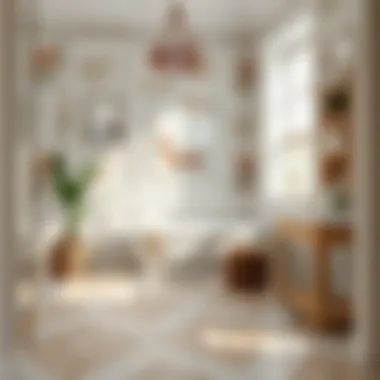
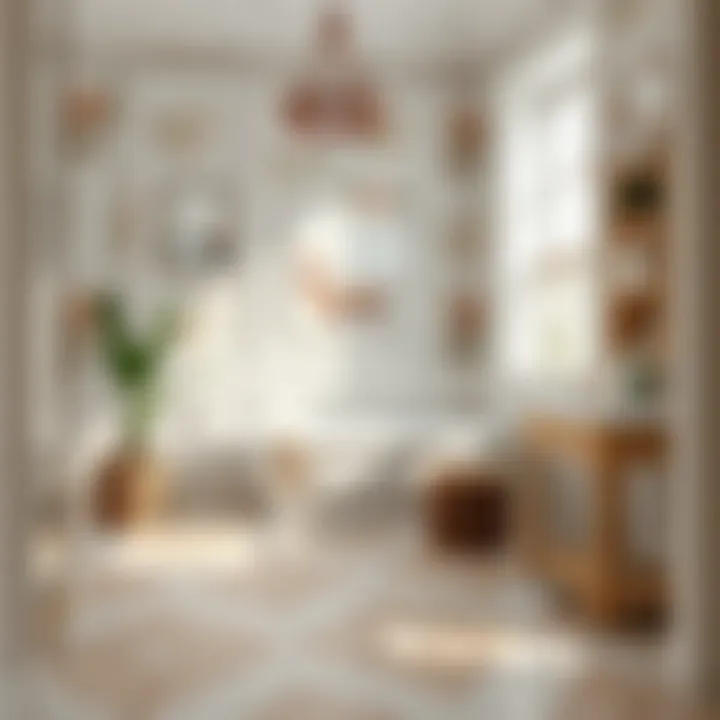
"Choosing eco-friendly materials can significantly improve your space while aligning with sustainable living practices. Recycled tiles and natural products stand out in performance and responsibility."
As you weigh your options, consider the importance of material choice not just on a personal level, but in relation to broader environmental sustainability. It's about crafting a space that reflects your values while delivering on functionality.
Pre-Installation Considerations
Before diving headfirst into the installation of peel and stick flooring, it’s crucial to take a step back and look at pre-installation considerations. Taking the time to prepare properly can mean the difference between a long-lasting floor and a project you're regretting down the line.
First off, understanding your environment is key. Bathrooms are notoriously humid spaces. A solid grasp of what your subfloor looks like can help in making informed choices. Ensuring that the area is clean and dry reduces the risk of issues like mold or mildew creeping into your new flooring. The last thing you want after laying down a beautiful floor is to find out that it’s peeling at the edges due to poor preparation.
Another important aspect is the layout planning. You can’t just slap down tiles anywhere; it’s essential to visualize the final outcome before you begin. By considering the size and shape of your bathroom as well as the existing fixtures, you can create a layout that feels both functional and aesthetically pleasing. A bit of foresight here can prevent a whole lot of headaches later on.
Benefits of Pre-Installation Considerations
- Enhanced Durability: Proper preparation can lead to longer-lasting results.
- Maximized Aesthetic Appeal: Effective planning enhances the overall visual impact of your bathroom.
- Reduction of Repair Costs: Without issues from the start, you can save on future repairs.
In summary, taking the time to prepare can greatly influence how pleased you are with your peel and stick flooring. Ready to tackle those details? Let’s break down how to prepare that subfloor.
Preparing the Subfloor
The first piece of the puzzle lies in preparing your subfloor. A solid foundation is indispensable for any successful flooring installation. Inspect the subfloor for any cracks, bumps, or irregularities. These issues can throw a wrench in your plans if not addressed.
Start by cleaning the surface thoroughly. Dust, dirt, and debris don’t just get in the way; they can also affect adhesion. After cleaning, check for moisture. Bathrooms are wet places, after all. If the subfloor feels damp, you've got to remedy that before laying down the new flooring. If you need to dry it out, consider using fans or dehumidifiers for a few days.
You may also want to use a leveling compound if there are any significant height variations. This ensures that each tile you place has a smooth, even surface to adhere to. It might take a bit of extra time, but a well-prepared subfloor is well worth your while.
Here are some crucial steps to prep your subfloor:
- Clean: Sweep and mop the surface thoroughly.
- Inspect: Look for cracks, chips, or other damage.
- Repair: Patch up any issues to create a smooth surface.
- Dry: Ensure the area is moisture-free.
- Level: Use leveling compounds if necessary.
Completing these steps carefully will greatly contribute to the success of your project.
Measuring and Planning Layout
Once your subfloor is prepped and ready, it’s time to dive into measurement and planning. This can feel overwhelming, but breaking it down makes it easier.
Start with measuring just about everything in your bathroom. You’ll want to know the length and width of the room, as well as the size of any fixtures that will affect your flooring layout. Having these measurements at your fingertips is essential for buying the right amount of flooring, but it also helps you visualize how different patterns and colors will fit into your space.
When you have your figures down, sketch a rough layout. This doesn’t have to be fancy—a simple drawing on a piece of paper will do. Plot out how the tiles will fit around the toilet, the sink, and any other significant features.
Considering a few layout tips can help:
- Start from the Center: This often leads to a more balanced look.
- Avoid Tiny Cuts: Try to position tiles so you avoid small, awkward pieces.
- Plan for Edges: Remember to account for how the tiles will go along the perimeter of the room.
With a solid plan in place, you’ll have the confidence to proceed with installation. When all is said and done, these preparatory steps will pay off, providing a beautiful bathroom floor that meets your expectations.
Installation Process
The installation process of peel and stick bathroom flooring is a pivotal segment of our comprehensive guide. Understanding this phase thoroughly can save homeowners time, effort, and potential headaches. This type of flooring is designed for easy installation, but success hinges on preparation and execution.
By following a structured approach, one can transform a bathroom with minimal disruption. Attention to detail during installation not only affects the immediate aesthetic but also influences long-term performance and durability.
Step-by-Step Installation Guide
Installing peel and stick flooring might sound simple, but it requires a careful methodology to ensure beautiful and lasting results. Here is a step-by-step guide:
- Gather Your Tools: Before diving in, collect all necessary tools. You’ll need a utility knife, a straight edge, measuring tape, a pencil, a clean cloth, and a rolling pin or heavy book to press down the tiles as you install.
- Prepare the Subfloor: A clean and level surface is crucial. Remove any existing flooring or debris. If the subfloor has moisture, allow it to dry completely. Fill in any cracks and smooth over rough areas to provide a stable base.
- Measure and Plan the Layout: It’s wise to plan the layout before you start sticking tiles. Measure the length and width of the bathroom and sketch a rough layout. This helps in identifying where to start and ensuring the pattern flows well.
- Cut the Tiles if Necessary: Before adhering the tiles, cut them based on your measurements, especially for edges or corners, where full tiles won’t fit. Always do a dry fit first to check your cuts.
- Start Installing: Begin in one corner of the room, preferably against a straight wall. Peel off the backing of the first tile and press it firmly onto the subfloor, aligning it with your planned layout. Use a rolling pin to press it downing firmly.
- Continue Laying Tiles: Work your way across the room, ensuring each tile is snug against the previous one, without gaps. If tiles need to be adjusted, do so quickly after placing to avoid adhesive setting.
- Finish the Edges: Once all tiles are installed, step back and check for any areas needing touch-ups. For edges, you may need to use your utility knife to trim excess millimeter off.
- Final Press: After laying all the tiles, use a rolling pin or heavy book to ensure they stick well and remove any air bubbles underneath.
By following these steps, the process becomes much more manageable, yielding a floor that looks professionally done.
Common Pitfalls to Avoid
Even the best plans can veer off course if certain missteps are made during installation. Here are a couple of common pitfalls to keep an eye out for:
- Not Cleaning the Surface: If dust and debris are left on the subfloor, they can affect adhesiveness. Make sure to vacuum and clean thoroughly before starting.
- Ignoring Moisture Levels: Bathrooms are often high-moisture areas. Failing to prep your subfloor for moisture can lead to problems down the line. Use moisture barriers if necessary.
- Rushing Measurements: Measure twice, cut once is an old saying, but it holds true here. Getting measurements wrong can cause extra work and frustrated finishes.
- Not Using a Roller or Book: Neglecting to press down on the tiles can leave gaps, leading to early wear and potential peeling. Use a heavy object to help with adhesion as you go along.
"Taking the time to prepare and follow through with careful steps can make a substantial difference in how your bathroom floor ultimately looks and performs."
Each of these pitfalls can derail your project and result in unintentional issues that are often costly to fix. Keeping these points in mind can ensure a smoother installation experience, allowing you to focus more on enjoying your newly designed space.
Post-Installation Care
Once the peel and stick flooring has been laid down, the journey doesn’t simply end there. In fact, the real attention needed comes in what follows the installation. Post-installation care is crucial, as it helps to extend the life of your floors and ensures they maintain their appeal over time. A little maintenance goes a long way, after all. Let’s explore some essential practices to keep your flooring in tip-top condition.
Cleaning and Maintenance Tips
Keeping your peel and stick flooring clean is vital. Regular maintenance not only helps with the visual aesthetics but also prevents long-term issues. Here are some key practices:


- Routine Sweeping and Mopping: At least once a week, give your floors a sweep to clear away dust and dirt. When mopping, dilute a gentle cleaner in warm water to avoid residue buildup.
- Avoid Harsh Chemicals: Strong, abrasive cleaning agents can damage the adhesive properties of your flooring. Stick with mild soaps or green cleaners that are safe for vinyl materials.
- Spot Cleaning: Accidents happen. If you spill something, clean it immediately with a damp cloth. Leaving stains can lead to long-lasting blemishes that could necessitate replacement.
- Use Mats and Rugs: High traffic areas are prone to wear. Invest in mats in places where people frequently walk, such as in front of sinks or showers, to absorb some of the impact.
- Check for Loosening: Occasionally, inspect the edges and seams of your flooring. If any areas seem to be lifting, use a roller or your hand to press them down firmly.
By adhering to these cleaning tips, you can keep your peel and stick flooring looking fresh and vibrant for years to come.
Recognizing When to Replace
Determining when to replace your peel and stick flooring can be tricky. With proper care, these floors can hang around for a while, but there are signs that it may be time to say goodbye. Here’s what to keep an eye out for:
- Stains That Won’t Budge: If you notice stubborn stains that refuse to come out even after trying numerous cleaners, it may signal replacement time.
- Visible Wear and Tear: Look for scratches, dents, or fading in color. If these are prominent and affect the overall aesthetic, it might be better to switch things up.
- Peeling or Lifting Edges: If segments start peeling or lifting, this can lead to further damage. While some can be reseated with adhesive, persistent lifting suggests a deeper issue.
- Water Damage: Given the bathroom environment, if you find any signs of water damage beneath the flooring, it’s essential to act swiftly. Not only could this damage your current flooring, but it could also harm the subfloor.
"A stitch in time saves nine," as the saying goes; recognizing signs early can help you avoid expensive redo costs down the line.
In summary, with consistent maintenance and awareness of potential issues, your peel and stick flooring can remain a charming and practical choice for your bathroom. Take care of those floors, and they’ll reward you by staying beautiful!
Design Ideas with Peel and Stick Flooring
Designing a bathroom is an exciting journey, and peel and stick flooring adds a touch of creativity and practicality. It’s not just about functionality; it's about visual appeal and making the space your own. When it comes to bathroom floors, the options are as wide as the ocean. With peel and stick flooring, you can change things up without breaking the bank or undergoing a massive renovation.
Creating Visual Interest with Patterns
Patterns can transform a dull bathroom into a stylish sanctuary. Choosing a pattern for your peel and stick flooring allows for various artistic expressions without overwhelming your space. Stripes, geometric shapes, or floral designs each bring their unique flair.
- Stripes: Vertical stripes can create the illusion of height, perfect for smaller bathrooms. On the flip side, horizontal stripes might make a long bathroom feel wider.
- Geometric Patterns: Bold, angular shapes can make a modern statement, catching the eye and adding depth. These can pair well with minimalist decor, enhancing the overall aesthetic.
- Floral Designs: If you're leaning towards a more classic look, soft floral patterns can evoke a sense of tranquility, reminiscent of an English garden. It’s ideal for creating a calm and serene environment.
By thoughtfully selecting patterns, you can guide the flow of the room, making it feel more expanded or cozy, depending on your preference.
Color Schemes and Themes
When you’re considering color schemes and themes, peel and stick flooring offers a rainbow of choices. The right colors can set the mood and tie the entire bathroom design together seamlessly. The color palette can reflect your personality while complementing existing fixtures and decor.
- Neutral Tones: Shades of white, gray, and beige create a clean, understated backdrop. This gives the freedom to play with colorful accessories without it all clashing together.
- Bold Colors: Deep blues, emerald greens, or rich maroons can evoke a luxurious feel. If you want your bathroom to feel like a spa retreat, consider these more intense hues.
- Monochromatic Themes: Sticking with varying shades of one color can create a sophisticated look. For instance, using different shades of blue from floor to wall can bring a sense of cohesion.
Incorporating these color choices and themes into your peel and stick flooring lets you tailor your space to reflect your style while maintaining a functional aspect. The beauty of this flooring method is not only in its ease of installation but also in the endless design possibilities it offers.
With creativity at the forefront, peel and stick flooring is more than just a practical choice; it is an invitation to elevate the aesthetic of your bathroom in a personal and unique way.
Helpful Resources
For further exploration of design options and trends, check out resources like Wikipedia or Britannica, which delve into historical and modern design concepts.
Comparative Analysis
Engaging in a comparative analysis of peel and stick flooring versus traditional options reveals significant differences that can influence decision-making for homeowners. This evaluation is essential, not just for clarifying their own expectations, but also for understanding their unique requirements within the context of bathroom renovations.
Peel and Stick vs. Traditional Flooring
When pitting peel and stick flooring against traditional flooring choices, like ceramic tiles or hardwood, the pros and cons wrangle a bit. Peel and stick materials score highly on convenience and affordability. They don't require heavy tools or specialized skills, making them a go-to for DIY enthusiasts. Homeowners can easily lay them down over most existing floors, provided the underlying surface is clean and smooth. It's almost akin to placing stickers on a scrapbook page – simple and straightforward.
In contrast, traditional flooring often entails extensive preparation and installation time. For instance, laying ceramic tiles demands a meticulous approach; it involves mixing mortar, ensuring precise alignment, and sometimes even grouting the spaces. While these methods can yield stunning results, the efficient installation of peel and stick is tough to beat. Though traditional flooring may be touted for its longevity, it also comes with a hefty price tag and significant labor costs which can wave goodbye to your budget.
Yet, traditional flooring typically offers greater durability and resilience in high-traffic areas. Over time, materials like vinyl and laminate could lose their adhesive properties, especially in moisture-laden spaces such as bathrooms. A deeper commitment with traditional flooring often means it's built to withstand the daily use and abuse of a bustling household.
Longevity and Cost Considerations
When discussing longevity, the differences between peel and stick flooring and traditional materials are notable. Traditional options like porcelain tile boast tremendous durability, often lasting generations with proper care. This kind of lifespan can be particularly appealing for homes that sit in one family for years. Conversely, peel and stick tiles are designed for shorter lifespans, typically around five to ten years at most.
Despite its limited durability, the labor and materials costs of peel and stick flooring usually result in significant savings. The installation process doesn’t requir extensive skills, and homeowners can save on professional help. Traditional flooring installations might require proper tools and expertise which barrel into larger financial commitments. It's pivotal to weigh the initial cost against expected lifespan.
Investing in traditional flooring often carries an eye-watering upfront expenditure but holds value over time. On the other hand, peel and stick flooring offers flexibility. Homeowners can revisit their design choices without breaking the bank. If aesthetics or trends shift, it’s much easier to replace peel and stick.
Ultimately, the choice between these two is deeply personal, hinging upon preferences, lifestyle, and budget. As one weighs the practicalities against the aspirations for their bathroom space, being informed about all options ensures a wise decision, tailored to individual needs.
Choosing flooring is not merely about aesthetics; it's an investment in your home's future.
Further Resources
For more information on this topic, readers may wish to explore:
Finale
As we wrap up this comprehensive exploration of peel and stick bathroom flooring, it's essential to reflect on the various elements that make this option appealing for both homeowners and design enthusiasts alike. Ultimately, the choice of flooring can either elevate or diminish the overall ambiance of your bathroom, and peel and stick flooring provides a balance of aesthetics and practicality.
Evaluating Your Options
Before jumping into installation, evaluating your options is key. Consider the material: vinyl flooring often comes out as a frontrunner due to its resistance to moisture and wear. Meanwhile, laminate might catch the eye with its beautiful finishes but can fall short under high humidity. Think about how the flooring will perform in your specific space. Another important factor is the design. With a plethora of styles available—ranging from sleek and modern to vintage or rustic—you'll want a look that complements your overall decor. Because this flooring is often self-adhesive, it can be tempting to choose the most visually striking option without considering durability or maintenance. Remember, it is a bathroom, and functionality should never take a backseat.
Thinking practically about costs also cannot be ignored. While peel and stick flooring generally offers a cost-effective solution, hidden expenses may arise when fixing uneven subfloors or needing additional materials. Sharpen your pencil and perform a thorough cost-benefit analysis before settling on one option.
Making Informed Decisions for Your Bathroom
Every decision you make can lead to either delight or regret down the line when it comes to flooring choices. Thus, doing your homework and weighing the pros and cons is integral. If you find a flooring option appealing but worry about longevity, reach out to professionals or customers with similar installations for their feedback. When it comes to your bathroom, considering elements like moisture resistance, long-term costs, and style cohesion can save you time and money in the future.
Ultimately, the right selection hinges not only on your present needs but also on anticipating future changes. For instance, if you're keen on selling your home in a few years, stick with more neutral designs that can appeal to a broader audience, rather than getting too wild with your choices. A thoughtful approach now will likely pay dividends later when you can show off a well-kept bathroom, which will undoubtedly become a focal point in your home.







